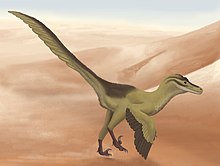Linheraptor
| Linheraptor Temporal range: Late Cretaceous,
| |
|---|---|

| |
| Artist's reconstruction | |
| Scientific classification | |
| Kingdom: | |
| Phylum: | |
| Class: | |
| Superorder: | |
| Order: | |
| Suborder: | |
| Infraorder: | |
| Family: | |
| Subfamily: | |
| Genus: | Linheraptor Xu et al., 2010
|
| Species | |
| |
Linheraptor is a genus of dromaeosaurid dinosaur which lived in what is now China in the Late Cretaceous. It was named by Xu Xing and colleagues in 2010, and contains the species Linheraptor exquisitus.[1] This bird-like dinosaur was less than 2 m (6.5 ft) long and was found in Inner Mongolia. It is known from a single, mostly complete skeleton.
Description

Linheraptor was a bird-like theropod dinosaur. It was a dromaeosaurid which measured approximately 1.8 metres (5.9 ft) in length,[1] and weighed up to approximately 25 kilograms (55 lb).[2] At that size, Linheraptor would have been a fast and agile predator, perhaps preying on small ceratopsians.[3] Like all dromaeosaurids, it had an elongated skull, a curved neck, an enlarged toe claw on each foot, and a long tail; Linheraptor was bipedal and carnivorous. The large toe claws may have been used for capturing prey.[3]
Discovery
Researchers announced the discovery of the genus after a nearly complete fossilised skeleton was found in 2008 by Jonah Choiniere and Michael D. Pittman[1] in Inner Mongolia; a more detailed publication is forthcoming.[1] The specimen was recovered from rocks at Bayan Mandahu. The rock formation is the Wulansuhai Formation, equivalent to the Djadokhta Formation of Mongolia dating from the Campanian; the Djadokhta Formation has yielded the related genera Tsaagan and Velociraptor.[1] The holotype specimen of Linheraptor, articulated and uncompressed, is one of few nearly complete skeletons of dromaeosaurid dinosaurs worldwide.[1] The name of the genus refers to the district Linhe, the district of Inner Mongolia where the specimen was discovered, while the specific name, exquisitus, refers to the well-preserved holotype (IVPP V 16923).[4]

Taxonomy
Among its sister taxa, Linheraptor is believed to be most closely related to Tsaagan mangas. Linheraptor and Tsaagan were intermediate between basal and derived dromaeosaurids. The two share several skull details, among which a large maxillary fenestra — an opening in the maxilla, an upper jaw bone — and lack various features of more derived dromaeosaurids such as Velociraptor.[1] Senter (2011) and Turner, Makovicky and Norell (2012) argued that Linheraptor exquisitus is in fact a junior synonym of Tsaagan mangas.[5][6]
References
- ^ a b c d e f g "A new dromaeosaurid (Dinosauria: Theropoda) from the Upper Cretaceous Wulansuhai Formation of Inner Mongolia, China" (PDF). Zootaxa (2403): 1–9. 19 March 2010. Retrieved 2010-03-19.
{{cite journal}}: Cite uses deprecated parameter|authors=(help) - ^ Richard Alleyne (2010-03-19). "'Beautiful' fossil of Jurassic Park dinosaur found". The Daily Telegraph. Retrieved 2010-03-21.
- ^ a b "Linheraptor Exquisitus - New Raptor Species Discovered in Mongolia". Science Blogging. Retrieved March 21, 2010.
- ^ Ker Than (2010-03-19). "New Dinosaur: "Exquisite" Raptor Found". National Geographic. Retrieved 2010-03-21.
- ^ Senter, Phil (2011). "Using creation science to demonstrate evolution 2: morphological continuity within Dinosauria (supporting information)". Journal of Evolutionary Biology. 24 (10): 2197–2216. doi:10.1111/j.1420-9101.2011.02349.x. PMID 21726330.
- ^ Alan Hamilton Turner, Peter J. Makovicky and Mark Norell (2012). "A review of dromaeosaurid systematics and paravian phylogeny". Bulletin of the American Museum of Natural History. 371: 1–206. doi:10.1206/748.1.
